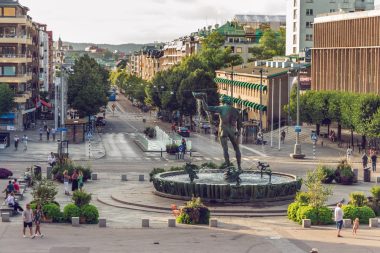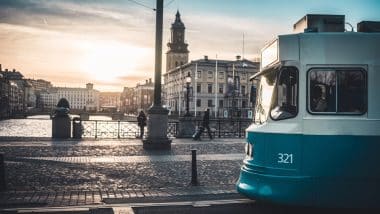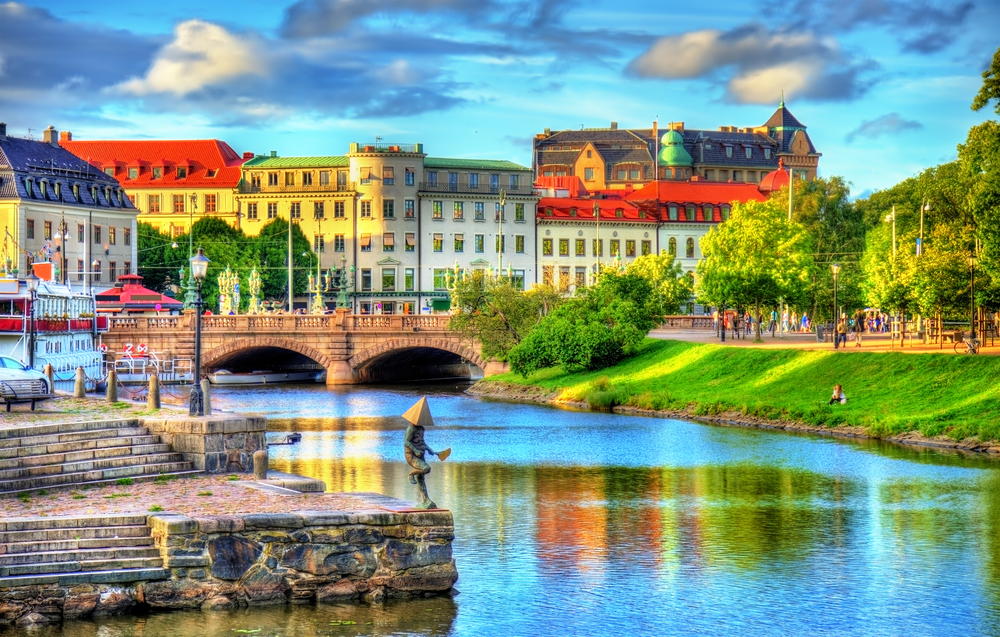Gothenburg, Sweden’s second-largest city and port city on the west coast, is a popular destination for travelers who want to combine a relaxed atmosphere with interesting attractions. Particularly worth seeing is the cobblestoned district of Haga with its many small and quaint shops that exude a charm of its own.
If you want to escape the hustle and bustle of the city, you should visit the really impressive archipelagos, which are among the most popular destinations. The northern and southern archipelago offer a fantastic environment with their small charming coastal villages, wonderful hiking trails and many small bays. Archipelago is the name given to the collection of small islands that make up Sweden’s coastal landscape. Gothenburg’s lake-rich hinterland also offers nature lovers many wonderful hiking trails along the lakes Sävelången, Lygnern, Mjörn, Aspen and Anten.
Sights and tourism in Gothenburg
One of Gothenburg’s many landmarks is the “Feskekörka”. Translated, this name means “fish church”. It was inaugurated in 1874 and designed by Victor von Gegerfelt. With its pointed arch windows and a structure without partitions, the building was already one of the most modern buildings at the time. However, there is no prayer in this church, because since 1874 it has only served as a restaurant and as a market hall for freshly caught fish, shellfish and mussels.
For art lovers, a visit to the Röhsska Museum with selected works by Swedish and international designers is a real treat. More than 50,000 objects can be visited, with a focus on design from the beginning of the 19th century to today’s IT society. In addition, there are three permanent exhibitions on the topics of design history of the Röhsska Museum, the inspiration of East Asia and the silver collection of Falk Simon.

To see the beauties of Gothenburg from the water, a trip on the so-called Paddan sightseeing boats is particularly suitable. The journey leads along old moats and canals, takes visitors under low bridges to the fishing port and the traditional shipyards, which are well worth seeing. There are many historic ships in the harbour that can be visited.
The Maritiman Museum cannot be compared to an ordinary museum. Twenty civilian and military ships are moored on the south bank of the Göta älv, which have joined together to form a truly unique museum. You can see the tug Hercules, built in 1939, the destroyer HMS Småland, the submarine Nordkaparen from 1961, the lightship No. 29 Fladen or the fireboat Flodsprutan II from 1931. There are also interesting exhibitions on some ships, where visitors can get a good insight into the life of a sailor.
Visitors to the maritime museum Sjöfartsmuseet Akvariet, which is located in the “old shipyard park” southwest of the city center of Gothenburg and was opened in 1913, have solid ground under their feet. More than 400 years of maritime history in Sweden are vividly presented here. Right next door is an aquarium with native sea creatures. It is one of the oldest aquariums in the world in which the Nordic underwater world is represented.
Magnificent views for visitors with a head for heights

Right next to the seamen’s harbour is the seamen’s tower “Sjömanstornet”. If you climb the 193 steps of the tower, you will reach a viewing platform at a height of 52 metres, from which you can get a great panoramic view of the city and the harbour.
The local mountain Ramberget on the island of Hisingen also offers a good view over the city with a height of 87 meters. With good visibility, you can even see as far as the island of Vinga in the Kattegat.
Typically Swedish?
Many people will have been familiar with the terms Köttbullar (meatballs) or Knäckebröd (crispbread) for a long time. Of course, there is a lot more to a classic Swedish meal, such as pickled herring (sill), fermented herring (surströmming), chanterelles (kantareller), capercaillie (tjäder), elk (älg) or salads such as Skagenröra, Räksallad, Mimosasallad or Rödbetssallad. Traditional drinks include beer (oil) and aquavit (akvavit).
Gothenburg is really very versatile and a worthwhile destination at any time of the year.
Holidays in Gothenburg: The most important information
Journey
- Airport: Gothenburg Landvetter Airport (GOT), about 25 km east of the city. Regular bus services (Flygbussarna) take travelers to the city center.
- Train: Good connections from other Swedish cities as well as international destinations via Gothenburg Central Station.
- Ferry: Ferry connections from Denmark and Germany, e.g. from Frederikshavn and Kiel.
Important telephone numbers
- Police: 114 14 (non-urgent cases), 112 (emergency)
- Fire brigade: 112
- Ambulance service: 112
- General emergency: 112
- Tourist information: +46 31 368 42 00
Supermarkets
- ICA: Several branches in the city, e.g. in Nordstan and Avenyn.
- Coop: Various locations, including in Vasastan and Linnaeus.
- Willys: Inexpensive supermarkets in various parts of the city.
- Hemköp: Several branches, e.g. in Nordstan and Linnéplatsen.
Doctors and hospitals
- Sahlgrenska University Hospital: Blå Stråket 5, +46 31 342 10 00
- Närhälsan Masthugget Vårdcentral: Fjällgatan 30, +46 31 747 80 00
- Citysjukhuset +7: Kungsportsavenyen 33, +46 31 777 77 77
Important words with translation
- Hello – Hej
- Thank you – Tack
- Please – Var så god
- Yes – Yes
- No – Nej
- Sorry – Ursäkta
- Where is…? – Var är…?
- How much does it cost…? – Hur mycket kostar…?
- Emergency – Emergency situation
- Doctor – Läkare
- Hospital – Sjukhus
Holidays
- New Year’s Day: January 1
- Epiphany: January 6
- Good Friday: variable (March/April)
- Easter Monday: variable (March/April)
- Labour Day: 1 May
- Ascension Day: variable (May/June)
- National holiday: 6 June
- Midsummer: variable (June)
- All Saints’ Day: November 1
- Christmas: December 25
- St. Stephen’s Day: December 26
Opening hours
- Shops: Usually Monday to Friday from 10:00 to 19:00, Saturday from 10:00 to 17:00, Sunday from 12:00 to 16:00.
- Supermarkets: Usually daily from 8:00 a.m. to 10:00 p.m.
- Restaurants: Lunch from 11:30 to 14:00, dinner from 18:00 to 22:00.
- Banks: Monday to Friday from 9:00 a.m. to 3:00 p.m., some until 6:00 p.m.
Things to see and do
- Liseberg: One of the largest amusement parks in Scandinavia.
- Universeum: Science center with aquarium and rainforest.
- Haga: Historic district with cobblestone streets and cozy cafes.
- Gothenburg’s Konstmuseum: Art museum with works by Nordic and international artists.
- Feskekôrka: Market hall for fresh fish and seafood.
- Archipelago: Explore the picturesque archipelago islands off the coast of Gothenburg with ferries and boat tours.
NUDISM
- Saltholmen: Unofficial nudist areas at this popular swimming spot.
- Brännö: Some secluded beaches on this island are known for unofficial nudist bathing.
Post / Stamps
- Post Offices: In larger districts and shopping malls. Main post office in Nordstan. Opening hours: Monday to Friday from 9:00 a.m. to 6:00 p.m.
- Stamps: Available at the post office, kiosks and supermarkets.
- Costs for letters and postcards to Germany: Standard letter up to 20g: approx. 21 SEK; Postcard: approx. 21 SEK
Safety
- Crime: Gothenburg is relatively safe, but as in any big city, you should be attentive. Beware of pickpockets in busy areas and markets.
- Emergency number: 112
Current
- Voltage: 230 volts
- Sockets: Type C and F (as in Germany)
Tip
- Restaurants: 5-10% of the bill amount, often included in the bill.
- Taxis: Round up the amount
- Hotels: 10-20 SEK per day for cleaning staff
Customs
- Allowances within the EU: No customs restrictions on personal belongings.
- Alcohol: Maximum 10 liters of spirits, 20 liters of alcoholic beverages with less than 22%, 90 liters of wine, 110 liters of beer.
- Tobacco: 800 cigarettes, 400 cigarillos, 200 cigars, 1 kg of tobacco.


